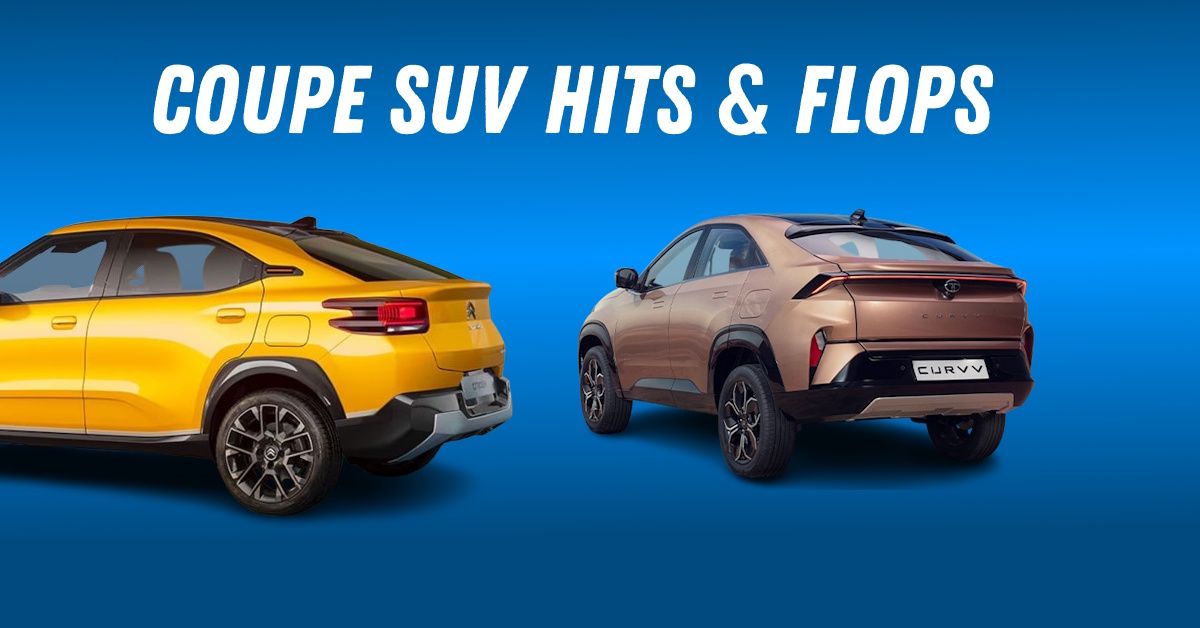India's Coupe SUVs, Their Popularity And Unpopularity: Some Lessons


The coupe SUV wave [under ₹30 lakh] is in full swing, but not every model is riding it with the same success. Over the past six months, this stylish sub-segment has grown more competitive, and with fresh entrants like the Tata Curvv (in both ICE and EV formats) and the Citroen Basalt, as well as Mahindra’s BE 6 and XEV 9e, it’s becoming clear that a coupe SUV is only as good as its execution.
Sales trends from May 2025 offer a telling snapshot. Mahindra’s electric duo, the BE 6 and XEV 9e, clocked a combined 4,021 units dispatched to dealers. The XEV 9e led with 2,815 units, while the BE 6 sold 1,206, both showing encouraging month-on-month growth. Meanwhile, Tata’s Curvv, combining ICE and EV volumes, held steady at 3,063 units, a minor drop from April’s 3,149. Citroen’s Basalt, however, remained on the fringes with just 95 units sold in May, despite recovering from a low of 47 units six months prior.
The success stories of Tata and Mahindra highlight a few key trends. One, flexibility in powertrain is proving crucial. The Curvv offers petrol and electric variants, while Mahindra has taken a modular approach with the BE 6 and XEV 9e, offering a range of battery options (59kWh and 79kWh) and plans to introduce hybrid variants soon. This flexibility caters to a wider audience and allows consumers to pick what suits their driving needs and budgets best.
In contrast, Citroen’s Basalt remains petrol-only. That limitation, coupled with the brand’s lower recognition and weaker sales network, has hurt its chances despite aggressive pricing. Even a price correction in early 2025 hasn’t done much to shake off the lukewarm buyer sentiment. The Basalt’s comparative success in markets like Brazil suggests the product isn’t inherently flawed, but the brand’s presence and positioning need work in India.
Another differentiator has been tech and features. Mahindra’s top-spec variants, particularly the Pack Three models for both electric SUVs, have found a strong following despite premium price tags. These versions offer high-end tech like panoramic sunroofs, triple screens, dual wireless charging, and powerful Harman Kardon audio systems. The numbers back this up: 73% of Mahindra’s bookings have been for the most expensive variants.
Tata has managed to strike a solid balance with the Curvv. Launched in late 2024, it opened with a strong 4,994 units in December and has averaged around 3,400 units per month since. The consistency is noteworthy, especially considering the ongoing pressure in the electric vehicle space. Tata’s EV market share has slipped from two-thirds to 35.4% in May 2025, but the Curvv continues to contribute meaningfully.
The Curvv EV, in particular, offers compelling range figures of 430km and 502km at competitive prices. This has helped it appeal to a mix of first-time EV buyers and existing Tata loyalists. The ICE Curvv, meanwhile, benefits from the brand’s existing dealership and service footprint.
Looking ahead, hybrids may provide the next big lift. Mahindra is reportedly working on hybrid versions of the BE 6 and XEV 9e, a move that could address range anxiety while offering better fuel economy in real-world conditions. For buyers still on the fence about going fully electric, a hybrid alternative within the same coupe SUV shell could tip the scales.
This also sets the stage for a broader shift in the segment, where versatility, not just design, will determine success. While the sloping roofline and sporty proportions remain key draws, buyers are no longer swayed by style alone.
In the under ₹30 lakh space, the coupe SUV segment has moved beyond being a novelty. Buyers are now discerning between good design and good value. Citroen’s struggle with the Basalt proves that pricing alone can’t carry a product if the brand lacks depth in reach and trust. On the other hand, the strong performance of Tata and Mahindra models highlights the power of a strong dealership network, diverse powertrain offerings, and thoughtful feature packaging.
The message is clear. Coupe SUVs are here to stay, but they’re not a guaranteed win. Brands must think beyond the design studio and focus on real-world usability, pricing logic, and post-sale experience. As newer entrants eye this space, they’ll do well to heed the lessons from both the top sellers and the underperformers. The silhouette may be coupe, but the strategy has to be all SUV.